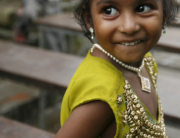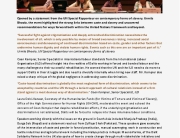Caste discrimination affects an estimated 260 million people
Caste discrimination affects an estimated 260 million people worldwide, the vast majority living in South Asia. It involves massive violations of civil, political, economic, social and cultural rights. Caste systems divide people into unequal and hierarchical social groups. Those at the bottom are considered ‘lesser human beings’, ‘impure’ and ‘polluting’ to other caste groups.
They are known to be ‘untouchable’ and subjected to so-called ‘untouchability practices’ in both public and private spheres. ‘Untouchables’ – known in South Asia as Dalits – are often forcibly assigned the most dirty, menial and hazardous jobs, and many are subjected to forced and bonded labour. Due to exclusion practiced by both state and non-state actors, they have limited access to resources, services and development, keeping most Dalits in severe poverty.
They are often de facto excluded from decision making and meaningful participation in public and civil life. Lack of special legislation banning caste discrimination or lack of implementation of legislation, due to dysfunctional systems of justice and caste-bias, have largely left Dalits without protection. Despite policy development and new legislation in some countries, fundamental challenges still remain in all caste-affected countries.
The progress that has been made is, to a large extent, a consequence of the tireless work of Dalit civil society groups in South Asia. They have also – through IDSN and by other means – managed to place caste discrimination firmly on the international human rights agenda. UN bodies and EU institutions are paying increasing attention to this issue.
The division of a society into castes is a global phenomenon not exclusively practised within any particular religion or belief system. In South Asia, caste discrimination is traditionally rooted in the Hindu caste system, according to which Dalits are considered ‘outcasts’. However, caste systems and the ensuing discrimination have spread into Christian, Buddhist, Muslim and Sikh communities. They are also found in Africa, other parts of Asia, the Middle East, the Pacific and in Diaspora communities.
A central feature of caste discrimination is the so-called “untouchability practices”. It stems from the notion that different caste groups have varying degrees of purity and pollution, with Dalits and other caste-affected groups being so impure that they can pollute other groups.
Paradoxically, sexual abuse and rape against Dalit women is not considered polluting to men from dominant castes.
If Dalits and other caste-affected groups challenge the untouchability practices, they often face violent sanctions and social boycott. Massive violations of human rights occur in relation to untouchability practices and other forms of caste-based discrimination.
Common untouchability practices:
-
Segregation in housing, schools and cremation grounds
-
De facto prohibition of inter-caste marriage
-
Limitation or prohibition of access to public places such as roads, temples and tea houses
-
Denial or limitation of access to public services such as water taps, health care and education
-
Restrictions on occupation; assignment of the most menial, dirty and dangerous jobs as defined by the caste hierarchy
-
De facto prohibition of access to ownership of land
The effect of untouchability practices and indeed the sexual abuse of “untouchable” women is that Dalits and other “untouchable” groups are kept powerless, separate and unequal.
Find out how these untouchability practices also constitute human rights violations
Database
IDSN has created an extensive database on caste-based discrimination.
Click here for all documents on untouchability
Other resources
Untouchability in Rural India by Shah, Mander, Thorat, Deshpande & Baviskar (2006)
Anthropology of Caste (from the International Encyclopedia of the Social Sciences, 2008)
Vidoes – Untouchability practices
Caste discrimination involves massive violations of civil, political, economic, social and cultural rights. Caste-affected communities are denied a life in dignity and equality.
According to a comprehensive UN study on discrimination based on work and descent, a number of human rights violations occur in relation to caste discrimination:
- The right to physical security and life and the right to be free from violence
- The right to equal political participation
- The right to fair access to justice
- The right to own land
- The right to equal access to public and social services
- The right to freedom of religion
- The right to marriage on free will
- The right to education
- The right to cultural identity
- The right to equal opportunity and free choice of employment
- The right to equal, just and favorable conditions of work
- The right to be free from forced or bonded labour
- The right to be free from cruel, inhumane or degrading treatment
- The right to health
- The right to adequate food, water, sanitation, clothing and housing
Impunity for the perpetrators of crimes against caste-affected groups and non-implementation of legislation permeates the justice and law enforcement systems. Dalit cases are often not reported, investigated or prosecuted properly. Policemen, lawyers and judges often belong to dominant castes and they are unwilling to investigate, prosecute and hear cases of crimes against Dalits. Very few cases of crimes against Dalits lead to conviction.
The United Nations Committee for the Elimination of Racial Discrimination recommends with specific reference to caste-affected communities that all states “take the necessary steps to ensure equal access to the justice system for all members of descent-based communities as well as ensure the prosecution of persons who commit crimes against members of descent-based communities and the provision of adequate compensation for the victims of such crimes.”
Learn more about how we work with the business sector on corporate social responsibility
See the Human Rights Correspondence School lessons on caste discrmination here
Database
IDSN has created an extensive database on caste-based discrimination.
IDSN considers caste (and related discrimination and exclusion) to be a unique phenomenon – though widely spread in different geographical regions and cultural contexts. Among other unique aspects of caste systems are the association with (traditional) occupation, beliefs concerning purity and pollution, and ‘untouchability’ practices. Although caste is distinct from the concept of race, both types of discrimination produce comparable forms of political, economic, and social exclusion.
Precisely because of its unique nature – as well as the vast numbers of people affected globally and the severity of associated human rights violations – IDSN believes that caste discrimination warrants separate and distinctive treatment in the UN human rights system.
IDSN considers the argument about whether caste is similar to race to be an unproductive debate on semantics. States have the principal duty to promote, protect and respect the rights of citizens affected by all forms of discrimination, including caste discrimination, in accordance with existing international human rights obligations. States must avoid serious implementation gaps of their obligations in order to adhere to the fundamental principles of equality and non-discrimination, regardless of the grounds on which discrimination is exercised.
Download full version of IDSN position paper on caste, race and descent
Commmittee on the Elimination of Racial Discrimination
In 2002, CERD adopted General Recommendation 29 on the term “descent” in article 1(1) of the Convention, which reaffirmed that caste-based discrimination falls within the scope of the Convention and therefore constitutes an effective framework to improve analysis and reporting on governments’ performance.
Read about UN treaty body observations on caste discrimination
UN Special Rapporteur on contemporary forms of racism
The UN Special Rapporteur has several times reaffirmed the position of CERD that discrimination on the grounds of caste falls within the scope of existing instruments, in particular the International Convention on the Elimination of Alls Forms of Racial Discrimination.
Read about the UN Special Rapporteur on racism and caste
Durban Declaration and Programme of Action
Read about the Durban Review Conference, DDPA and caste discrimination
More information:
IDSN recommendations to the Human Rights Council
UN Principles and Guidelines on the effective eliminate of discrimination based on work and descent



